I am arguing that the mechanism used to attach these differences is the political mobilization around rising charges of gender-based violence. In late 2016 and early 2017, NiUnaMenos provided a space by which a common battle towards gender violence, and especially towards feminicide, was capable of convey Bolivian feminist activists collectively. In this way, NiUnaMenos served as a novel new space of articulation by which previously disparate groups have been in a position to build coalitions within the face of increasing rates of femicidal violence. In the early 2000s, one of many community’s main foci turned working on what would ultimately become Law 348. In a departure from the previous regulation, 1674, which dealt solely with “violencia en la familia,” civil society members like Monica Bayá and her colleagues labored to ensure that Law 348 would widen the scope of what can be considered violence by the regulation. Over the course of greater than a decade, la Comunidad de Derechos Humanos worked in partnership with different members of feminist civil society, state establishments, and the workplace of the United Nations High Commissioner for Human Rights in Bolivia to put in writing this regulation .
The Institute for Normalization of Quality, a semi-autonomous authorities agency, operated a “triple seal” certification program for sugar producers whose final products had been certified to be free of kid and compelled labor, which may reduce the demand for compelled labor. In 2019, civil society organizations noted a rise in baby sex tourism near vacationer areas of the La Paz and Beni Departments. Despite the considerations and willingness of the tourism police to analyze, authorities were allegedly limited of their capability to do so given language limitations. Authorities reported identifying 422 victims , of which 289 had been female, 113 were male, and 20 unknown; 250 have been underage, 121 were adults, and fifty one unknown.
The infrastructure of Bolivia’s training system, notably in rural areas, could be very underdeveloped, making ladies’ access to training bleaker. However, the nation is making strides to enhance the standard of its education system. Here are 10 details about women’ training in Bolivia and the implemented legal guidelines and programs in place to enhance it. «Thanks to the people’s struggle,» Morales mentioned, «there’s participation of essentially the most marginalized sectors in the history of Bolivia, who have been women and the indigenous movement.» Authorities performed quite a few consciousness-raising campaigns in the course of the 12 months. In addition, it educated forty % of its workers on trafficking prevention, and facilitated 21 consciousness workshops for drivers and bus terminal workers, reaching more than 9,600 individuals.
In 2019, authorities conducted a hundred forty five inspections in areas with a excessive prevalence of trafficking however did not report figuring out any victims. The Government of Bolivia doesn’t totally meet the minimum requirements for the elimination of trafficking however is making significant efforts to do so. The government demonstrated total increasing efforts compared to the earlier reporting period; therefore Bolivia was upgraded to Tier 2.
However, the government did not meet the minimum standards in several key areas. It did not prosecute any traffickers, care supplied to victims was inconsistent, instances involving complicit officials remained open, and for the second 12 months in a row, it didn’t report figuring out any victims of compelled labor exploited inside the country. This story focuses on how the women in Tiraque, a municipality positioned at 3300 meter height within the Cochabamba valley, adapt to local weather change. In the final ten years consideration has been given by NGO’s as well as the federal government to lower this gender gap and Bolivia now could be in a process of emancipation. The spotlight shines on a gaggle of girls distributors turned actors who recount tales of gender-based violence. The performs, presented in Aymara, are additionally geared toward indigenous communities the place almost half of all reports of gender-based violence takes place, in accordance with 2017 figures from the National Statistics Institute. “Kusisita” is certainly one of two plays provided by the Kory Warmis — Women of Gold in the Aymara language — troupe and both give attention to the issues of gender violence and convincing women to reject it.
Brazil’s Indigenous Search Help With Covid
com is actually an international dating site that possesses a major database. Dating on-line possesses its downs however once you discover a Bolivian girl, you’d know it was worththe problem. They have an excellent particular person that is going to continually waste your ideas. The character remains when attraction discolors, bolivian women are actually conveniently a mix of both. bolivian women want to be truly appreciated as an individual and besides self-looking for intents. Consequently, maintain your chats courteous until maybe if you’ re conversant withone another.
«Kusisita,» a piece that seeks to lift consciousness about violence against women and mobilize people to struggle it, has been drawing large audiences in Bolivia, which has certainly one of South America’s highest rates of femicides. In this April 30, 2019 photo, the spotlight shines on a group of women vendors turned actors who recount stories of gender-based mostly violence, at the Municipal theater of La Paz, Bolivia.
Do S Of Dating A Bolivian Female
In this century, should you uncover a lady that prizes dedication, at that point that’ s a gold mine right definitely there. It ‘ s terrific when you discover somebody that goes to per alongside withyou on taking care of that portion of your life. Bolivian new brides are reared in household items which might be actually sturdy and deal with eachother. Therefore should you’ re appearing a long run connection that may definitely result in relationship, bolivian women are literally an excellent selection. It might definitely not be truly as industried as different nations, actually, it’s generally uncared for amongst SouthUnited States nations nonetheless that neglects what it makes use of. While basic magnificence is actually subjective and also could’ t definitely be really evaluated, bolivian women are exceptional all elements thought of. Bolivia’ s multiculturalism permits her women to become pliable and recognize varied recommendations merely reviewed to several.
Bolivian Women Protest Towards Gender
Granted, even this understanding is a major advancement from the previous authorized paradigm, Law 1674, which thought of and guarded women solely from violence perpetrated in a familial context, in which they cohabitated, had been married, or shared kids together. Autonomous feminist activists who sat down with me had a fantastic deal to say concerning the ways in which NGOs produce discourse round problems with gender-based violence and feminicide, and infrequently highlighted the limiting and depoliticizing nature of NGO strategies. These critiques stem from the discursive formations that NGOs create round gender violence, which seep into public opinion and become hegemonic actuality. Beyond the ideological distance between the NGOs and some of their autonomous counterparts inside the articulation, there are additionally very real disagreements on the sorts of strategies that may and ought to be used to fight growing charges of violence. In the Articulación Feminista de La Paz y El Alto, we are definitely seeing a “complex structure” being created via variations as much as by way of similarities.
Gender Equality Observatory
The episode spoke of slightly noticed but important development in Latin America’s most indigenous nation — a brand new technology of indigenous women, urban and professionally ascendant, who honor the customs of the past but embrace trendy Bolivia, Western costume and all. «Kusisita» is certainly one of two plays supplied by the Kory Warmis — Women of Gold in the Aymara language — troupe, and both give attention to the problems of gender violence and convincing women to reject it. «Kusisita,» a work that seeks to raise awareness about violence in opposition to women and mobilize people to fight it, has been drawing large audiences in Bolivia, which has one of South America’s highest rates of femicides. «Kusisita» is one of two plays provided by the Kory Warmis — Women of Gold within the Aymara language — troupe, and both focus on the problems of gender violence and convincing women to reject it.
Most Unimaginable Issues To Do Whereas Backpacking In Bolivia
Separately, the Office of the Ombudsman recognized and referred 63 victims, including forty four from La Paz department, to shelters around the country . Authorities used the newly adopted sufferer identification handbook for regulation enforcement and the sufferer identification referral mechanism. In 2019, the nationwide police organized eight training sessions reaching greater than 400 police officers from across the nation on using the police sufferer identification handbook . The Ministry of Health continued to administer periodic medical checks to individuals in commercial sex, however it didn’t display screen for trafficking indicators. In August, authorities trained 35 well being officers on trafficking indicators. The MOL employed 14 labor inspectors charged explicitly with investigating cases of child labor and compelled labor and an additional 102 labor inspectors, who had the authority to research potential pressured labor instances.
The national police organized a march for World Day Against Trafficking raising awareness in four departments across the nation the place 27,000 college students participated. In addition, it carried out courses on trafficking awareness targeting students, parents, faculty directors, and academics. The MOJ and the MOL also performed campaigns reaching 3,000 college students bolivia women across the La Paz division and 588 university college students across the nation, respectively. One of the sub-ministerial entities charged with combating trafficking conducted necessary training for 5,000 small-enterprise operators that sought to participate in a month-long public cultural truthful. The government didn’t make efforts to cut back the demand for business sex acts.
“Kusisita,” a piece that seeks to raise awareness about violence against women and mobilize folks to battle it, has been drawing massive audiences in Bolivia, which has certainly one of South America’s highest rates of femicides. For some young indigenous women, the assumption that they may face discrimination or be taunted as rural hicks has prompted them to drop the traditional clothes. But the shift has as a lot to do with type and a contemporary sense of trend, which has touched even the insular world of Bolivia’s Quechua and Aymara Indians on this most isolated of nations, landlocked in the course of South America. But even in this country — Latin America’s most indigenous, the place maybe 70 % of its nine million persons are of Indian descent — the way forward for the pollera and derby hat is far from certain. By the early 20th century, said David Mendoza, a sociologist who studies indigenous tradition, women had settled on the clothing of turn-of-the-century Spain. Bolivia’s 1952 revolution, which was largely spearheaded by Indian miners and overturned the old social order, only cemented the custom.
I spent ten weeks between May and July 2019 conducting ethnographic research in Bolivia for this project. My time was spent mostly within the capital metropolis of La Paz, with short journeys to Santa Cruz and Sucre. The two major procedures of my in-individual research have been audio-recorded interviews with people and participant observation at public events. In recruiting members for interviews, I sought out people concerned in feminist activism very broadly talking, starting from autonomous activists and staff at nongovernmental organizations to lecturers and writers. In addition to these interviews, I also engaged in lots of informal conversations concerning the topic and attended events and marches in La Paz. Since the early 1970s, schooling from ages 6 to thirteen has been mandatory in Bolivia. However, nationwide education charges after major faculty have decreased drastically, with lower than a quarter of young adults attending.









